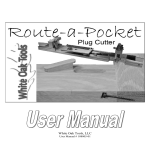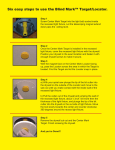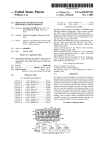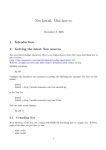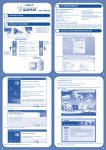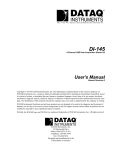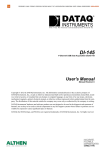Download the Route-a-Pocket User Manual
Transcript
White Oak Tools, LLC User Manual # 108000-06 Route-a-PocketTM Components Patent Pending Optional Hardware Route-a-PocketTM Hardware Optional Hardware i Quantity 1 1 1 1 1 5 5 5 1 1 Component Route-a-PocketTM assembly Route-a-PocketTM router bit 9/64” dia. drill bit #2 ball tip square drive driver Storage tube #7 x 1” pocket screw #7 x 1-1/4” pocket screw #7 x 1-1/2” pocket screw Mounting plate with (3) screws #2 ball tip square drive screwdriver Part # 101000 106008 104001 106010 106012 106060 106061 106062 101001 106009 White Oak Tools, LLC Route-a-PocketTM Components Route-a-PocketTM User Manual, Overlay & Template www.routeapocket.com Quantity 1 1 1 Component User Manual Set-up & Screw Selection Template Transparent Screw Overlay Part # 108000 108001 108002 ii Route-a-PocketTM Components Exploded View of Main Assembly iii Item # 1 2 3 4 5 6 7 8 9 10 11 Part Name Body assembly Drill guide assembly Lower stop block assembly Upper stop block assembly Retaining pin Hex bolt Wing Nut Shim (set of 4) Edge pad Clamp pad Label (set of 4) Part # 101002 101003 101004 101005 106002 102002 102003 106004 106003 106011 108003 White Oak Tools, LLC Route-a-PocketTM Components Exploded View of Optional Mounting Plate www.routeapocket.com Item # 11 20 21 Part Name Label (set of 4) Mounting plate assembly Wood screws Part # 108003 101001 102007 iv Table of Contents & Introduction Table of Contents Section Route-a-PocketTM Components Table of Contents & Introduction Route-a-PocketTM Specifications & Required Tools Using the Template & Adjusting the Stops Setting the Drill Bushing Height Plunge Router & Power Drill Set-up Machining Procedure Aligning the Pilot Hole with the Pocket Assembling the Joint Using the Optional Mounting Plate Joining 2 or More Route-a-Pockets & Maintenance Customer Support Page # i v 1 2 7 8 11 18 20 24 27 28 Introduction: Thank you for choosing Route-a-PocketTM. The Route-a-PocketTM has been designed to produce professional quality pocket screw joinery with your plunge router and power drill. Please take the time to read and understand this user manual in its entirety. By doing so, you’ll be introduced to all the jig’s features. We also suggest you practice using the Route-a-PocketTM on test pieces prior to using it on your next project. This step will build your confidence with the jig and ensure you have configured the Route-aPocketTM to produce the anticipated results. Finally, don’t forget to visit the Route-aPocketTM website (www.routeapocket.com). The site includes an interactive “Set-up & Screw Selection Template” along with other useful resources. v White Oak Tools, LLC Route-a-PocketTM Specifications & Required Tools Route-a-PocketTM Specifications Allowable Workpiece Thickness Minimum: 1/2" Maximum: 1-1/2” Pocket Width 3/8” Pocket Length Minimum: 1/2” Maximum: 4-1/8” Pilot Hole Diameter 9/64” Pocket & Pilot Hole Angle 10° Screw Grip Length Minimum: 7/16” Maximum: 1-1/8” Required Tools: Plunge Router For your safety, it is important that you select a good quality and well maintained plunge router for use with the Route-a-PocketTM. Selecting the proper plunge router will also make it easy to achieve the quality results you expect. The plunge router must accept a router bit with a 1/2” shank and should have a plunge stroke of at least 2-3/8”. The maximum suggested plunge router horsepower rating is 2-1/4. Guide Bushing The guide bushing must be compatible with your plunge router and have an outside diameter of 3/4". The collar length should be 1/2" or longer. Power drill The power drill used to drive the pocket screws should be equipped with an adjustable clutch. www.routeapocket.com 1 Using the Template & Adjusting the Stops Included with your Route-a-PocketTM is the Set-up & Screw Selection Template. This template makes it easy to select the appropriate screw and Route-a-PocketTM settings for your joining application. The template may be used by placing an actual screw on the card or by overlaying the transparent screw overlay, also included, on the card. This section describes the process. Notes: For most applications, the suggested Route-a-Pocket settings are listed on the back cover of this User Manual. An interactive Set-up & Screw Selection Template is available on-line at www.routeapocket.com. Figure 1a - Caution, template shown above is not full scale Place the centerline of the desired screw on the sloped line corresponding to the workpiece thickness. In this example, a #7 x 1-1/2” long screw is to be used with a 3/4” thick workpiece. 2 White Oak Tools, LLC Using the Template & Adjusting the Stops Figure 1b – Caution, template shown above is not full scale Choose the lower stop position by sliding the screw along the sloped line and align the bottom side of the screw head with the lower stop position that provides the desired grip length and penetration. In this example, the screw is aligned with 24B. Confirm that the screw penetration does not exceed the width or thickness of the mating workpiece and adjust if necessary. In this example, the screw will not break through a mating workpiece that is at least 1” wide and 3/4” thick Record the selected lower stop position. In this example, 24B is recorded. www.routeapocket.com 3 Using the Template & Adjusting the Stops Figure 1c – Caution, template shown above is not full scale Choose the upper stop position by repositioning the screw along the sloped line until the tip of the screw is aligned with the second line to the right of the previously recorded lower stop position. Positioning the tip at this location represents the tip of the screw entering the pilot hole 1/4”. In this example, the tip of the screw is aligned with 35B. Observe the upper stop position corresponding with the first line to the left of the screw head. Confirm that there is adequate driver access and adjust if necessary. In this example, the driver has adequate access when used at 25° off angle and the upper stop is positioned at 56C. Record the selected upper stop position. In this example, 56C is recorded. 4 White Oak Tools, LLC Using the Template & Adjusting the Stops Figure 1d Remove the pins and orient the stop blocks with the recorded stop block letters visible from above. In this example, the lower stop block is oriented to the “B” position (24B). The upper stop block is oriented to the “C” position (56C). Note: The stop block letters must be oriented right side up when read from the drill guide end of the Route-a-PocketTM. In this example, stop block letters “A” and “D” are hidden from view on the reverse side of the stop blocks. www.routeapocket.com 5 Using the Template & Adjusting the Stops Figure 1e Insert the pins through the recorded hole numbers making sure both legs pass through its respective stop block. In this example, the lower pin is inserted through holes 2 & 4 (24B), while the upper pin is inserted through holes 5 & 6 (56C). 6 White Oak Tools, LLC Setting the Drill Bushing Height Figure 2a Loosen the 2 wing nuts. Slide the drill guide and scale until the index (small slits on each side plate) is aligned with the mark corresponding to the workpiece thickness. In this example, the index is aligned with 3/4”. Tighten the 2 wing nuts. www.routeapocket.com 7 Plunge Router & Power drill Set-up Figure 3a Install a 3/4” outside diameter guide bushing (not included) and the supplied router bit following the safety and operating instructions provided with your plunge router and guide bushing. Note: Confirm that the guide bushing is concentric (centered) to the router bit. If adjustment is necessary, consult the operating/user manual that came with your router. Additional information on this topic can be found in the section entitled Aligning the Pilot Hole with the Pocket. 8 White Oak Tools, LLC Plunge Router & Power drill Set-up Note: Scale not included on older models Figure 3b Using the Set-up & Screw Selection Template, set the plunge depth by aligning the tip of the router bit with the line corresponding to the workpiece thickness. On newer model Route-a-Pockets, the plunge depth may be set using the scale located near the thumb screw. In this example, the plunge depth has been set for a 3/4” workpiece. www.routeapocket.com 9 Plunge Router & Power Drill Set-up Figure 3c Adjust the plunge stroke such that the router bit fully retracts into the guide bushing. Confirm that the router collet and bit do not contact the guide bushing or base plate at any point through the entire plunge stroke. Figure 3d Install the supplied 9/64” diameter drill bit following the safety and operating instructions provided with your power drill. 10 White Oak Tools, LLC Machining Procedure Figure 4a Secure the workpiece to your workbench. Position the Route-a-PocketTM near the workpiece. Figure 4b Rest the Route-a-PocketTM on the workpiece. Figure 4c Slide the Route-a-PocketTM over against the edge of the workpiece. Figure 4d Securely tighten the thumb screw. www.routeapocket.com 11 Machining Procedure Figure 4e Position the plunge router over the Routea-PocketTM. Note: Follow the safety and operating instructions that came with your plunge router. 12 Figure 4f Rest the router base plate on the incline of the Route-a-PocketTM. Make sure the guide bushing is between the upper and lower stops. White Oak Tools, LLC Machining Procedure Figure 4g Slide the router up the incline until the guide bushing is against the upper stop. www.routeapocket.com Figure 4h Turn the router on. Plunge the router to the bottom of its plunge stroke. 13 Machining Procedure Figure 4i Slide the router down the incline until the guide bushing is against the lower stop. 14 Figure 4j Slide the router back up the incline until the guide bushing is against the upper stop. This step clears the chips from the pocket. White Oak Tools, LLC Machining Procedure Figure 4k Return the router to the top of its plunge stroke. www.routeapocket.com Figure 4l Turn the router off. Lift the router off the Route-a-PocketTM. 15 Machining Procedure Figure 4m Position the power drill near the front of the Route-aPocketTM. Note: Follow the safety and operating instructions that came with your power drill. Figure 4n Start the power drill. Guide the drill bit through the drill bushing. Continue until the drill bit enters the pocket. Note: It may be necessary to partially retract the drill bit, to clear the chips, prior to the bit entering the pocket. 16 White Oak Tools, LLC Machining Procedure Figure 4o Back the drill bit out of the drill bushing. Stop the power drill. Figure 4p Loosen the thumb screw. www.routeapocket.com Figure 4q Remove the Route-a-PocketTM from the workpiece. 17 Aligning the Pilot Hole with the Pocket A B Figure 5a When looking into the pocket, the pilot hole should be centered in the pocket as shown at “A”. If the pilot hole is off center, as shown at “B”, adjustment is required. Start by confirming that the guide bushing is concentric (centered) to the router bit. If they are not concentric to each other, consult the operating/user manual that came with your plunge router and make the necessary adjustments. 18 White Oak Tools, LLC Aligning the Pilot Hole with the Pocket Figure 5b Often, it is difficult to make the guide bushing concentric with the router bit. For this reason, your Route-a-PocketTM has been designed with shims on the sides of the drill guide. These shims can be used to correct for misalignment between the pilot hole and pocket. Your Route-a-PocketTM was shipped with (1) thin and (1) thick shim on each side of the drill guide. By moving the shims from one side to the other, the pilot hole can be shifted relative to the centerline of the pocket. Reposition the shims as needed to center the pilot hole in the pocket. For reference, the thin shims are 0.02” thick and the thick shims are 0.04” thick. Note: To maintain proper side plate spacing, all (4) shims must be used at all times. www.routeapocket.com 19 Assembling the Joint Figure 6a Install the supplied driver bit and adjust the clutch setting following the safety and operating instructions provided with your power drill. Figure 6b Or select the optional screw driver. 20 Figure 6c The driver bit and screwdriver are designed with a #2 square drive ball tip end. This feature allows the driver to be used off angle up to 25°. White Oak Tools, LLC Assembling the Joint Figure 6d Rest the pocket workpiece and its mating workpiece on a flat work surface. Figure 6e If desired, add glue to the joint interface. Align the workpieces and push them tightly together. Figure 6f Clamp both pieces to the flat work surface. www.routeapocket.com 21 Assembling the Joint Figure 6g Position the tip of the screw in the pilot hole. Begin to drive the screw with the driver off angle, if required. Figure 6h Drive the screw home. Note: The driver can become less off angle as the screw approaches home. 22 White Oak Tools, LLC Assembling the Joint Figure 6i Remove the clamp. Figure 6j The joint is now complete. www.routeapocket.com 23 Using the Optional Mounting Plate The optional Route-a-PocketTM mounting plate saves time when working with smaller workpieces. Once the Route-a-PocketTM is “snapped” into its mounting plate, tightening the Route-aPocket’s thumb screw not only secures the Route-a-PocketTM to the workpiece, it also secures the workpiece to the workbench. This section describes how to use the mounting plate. Figure 7a The mounting plate is typically secured to a piece of 1/2” plywood (not included). As the plywood will be used as a work surface, it should be flat and smooth. The suggested minimum plywood dimensions are 12” wide x 24” long. Fasten the mounting plate to the “bad” side of the plywood using the 1/2” screws provided. The (2) front screws should be positioned 1/2" from the edge of the plywood. Note: The head of the rear screw must fit into the notch of the small plate. This will prevent the plate from rotating during use. 24 White Oak Tools, LLC Using the Optional Mounting Plate Figure 7b With the mounting plate facing down and hanging over the edge of your workbench, secure the plywood to your workbench. Remove the clamp pad (1) (it may be stored in the storage tube) and slide the Route-a-Pocket’s swivel pad between the spring loaded plates (2). The Route-a-PocketTM will snap securely into position when the swivel pad finds the large hole in the mounting plate assembly. Note: The tab on the mounting plate assembly will fit between the Route-a-PocketTM side plates when properly engaged. www.routeapocket.com 25 Using the Optional Mounting Plate Figure 7c Route-a-PocketTM shown properly engaged with the mounting plate. 26 White Oak Tools, LLC Joining Two or More Route-a-Pockets & Maintenance Figure 8a Your Route-a-PocketTM has been designed with two spare through holes. These through holes may be used to join multiple Route-a-Pockets at fixed distances from each other. This is often useful when multiple pockets are needed on multiple workpieces. To join two or more Route-a-Pockets, slide a 1/4” diameter threaded rod (not included) through each spare hole. Position the Route-a-Pockets along the rods using nuts (not included) on both sides of each Route-a-PocketTM. Maintenance To keep the plunge router sliding smoothly over the incline surface of the Route-aPocketTM, periodically apply a coat of good quality silicone free paste wax to the surface of the incline. www.routeapocket.com 27 Customer Support Feel free to contact us at: White Oak Tools 4840 Adams Rd. Rochester, MI 48306 Email: [email protected] Website: www.routeapocket.com Telephone: (248) 891-7198 Additional Route-a-PocketTM components and accessories can be ordered from our website or by telephone. Thank you for choosing the Route-a-PocketTM System. 28 This page intentionally left blank. Suggested Route-a-Pocket Settings Workpiece Thickness (in) #7 Screw Length Plunge Depth & Drill Guide Height Lower Stop Position Upper Stop Position TM 1/2 1 1/2 35B 67D (note 1) 5/8 35A 56D 5/8 1-1/4 3/4 1-1/2 3/4 35A 56D 1 1-1/2 1 35A 56C 1-1/4 1-1/2 1-1/4 35B 45D 1-1/2 1-1/2 1-1/2 35B Note 1: Note 2: Note 3: Note 4: (note 2) (note 3) Can not be plugged. If plugging, set plunge depth & drill guide height to 3/4”. If plugging, set plunge depth & drill guide height to 1-1/4”. If plugging, set Upper Stop to 45D. www.whiteoaktools.com 45C (note 4)




































